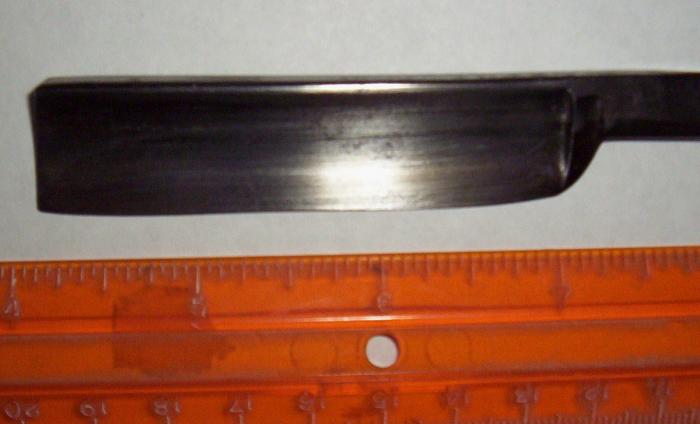Results 1 to 10 of 72
Hybrid View
-
12-12-2008, 08:34 AM #1At this point in time...




- Join Date
- Jun 2007
- Location
- North Idaho Redoubt
- Posts
- 27,084
- Blog Entries
- 1
Thanked: 13249
-
The Following User Says Thank You to gssixgun For This Useful Post:
bpave777 (12-12-2008)
-
12-12-2008, 09:54 AM #2Member

- Join Date
- Oct 2008
- Location
- Adelaide Australia
- Posts
- 72
Thanked: 6
i came close to breadknifing one of my razors i got recently, which wasn't flat, or a nice smile, had a kind of wave about it in the middle, but rather than starting again i taped it up and just took some time on a 1k until it was fixed, unsure if thats what would normally be the go, but it worked well
-
12-12-2008, 12:47 PM #3

and the good news is that an x pattern isn't needed . . .

-
12-12-2008, 02:40 PM #4
-
12-12-2008, 07:55 PM #5

With all due respect to all the members here, especially the experianced ones, I find that people go overboard with a lot of techniques described on this board. Let me explain...When most of these razors were new, that could be any time in the 1700s, 1800s, or 1900s, they were used for shaving exclusively. They didn't have Mach3s in 1898 or electric razors, the straight razor was your only choice really. Anyway I'm sure that when it came time to hone their razor that the owner didn't have 5 seperate stones to their disposal. They probably had a barber hone and a strop, possibly another strop loaded with mild abrasives. They likely honed it and stropped it and if it shaved half decent that was good. I feel blessed to have a Norton in 4000 and 8000 grit, that is more then they would have had to use. I can see if you are going at it as a hobby and your goal is to have the ultimate shaving edge, by all means become and honemiester and have 5 or so stones at your disposal while honing. If all you want is a good shave then something like a
Norton works fine. Personally I have breadknifed a razor, it kept chipping on the edge while honing it. Breadknifing it worked well and although it took me a long time to get the bevel back, it was worth it in the end. I'm by no means an expert, I'm just a beginner, but I use common sense and I have found honing a razor to the point of getting a good shave to be way easier then it is often made out to be in the forums here, maybe I've just been lucky with the five razors I've honed so far.
-
12-12-2008, 08:05 PM #6
 Find me on SRP's official chat in ##srp on Freenode. Link is at top of SRP's homepage
Find me on SRP's official chat in ##srp on Freenode. Link is at top of SRP's homepage
-
12-12-2008, 08:13 PM #7At this point in time...




- Join Date
- Jun 2007
- Location
- North Idaho Redoubt
- Posts
- 27,084
- Blog Entries
- 1
Thanked: 13249
EXACTLY!!!! same point I was making in my first post to this thread....
Give me a new Dovo, TI, or a NOS vintage and I'll be shaving in 30 minutes... as will anybody else who knows their way across a hone....
But were not talking about those here....
Were talking serious metal removal, ie: just shy of a re-grind...
-
12-12-2008, 08:23 PM #8

I breadknife almost every vintage or used razor I get. If the contour/profile of the edge doesn't need changed then I do it with several very light strokes just to be sure that I'm putting a new set of bevels on the edge. Just enough to make the entire edge fail the TNT before beginning to reset the bevels. If the entire edge already fails the TNT, as some vintage and used razors do, then I often do not breadknife it.
If the razor's profile has a frown, nicks, or other damage, then it gets heavier breadknifing until the profile is where I want it. I think breadknifing my way to a new edge profile, followed by setting bevels, is faster than just "normally" sharpening the bevels to a new profile shape. Either way, you end up removing the same amount of metal.Last edited by Sticky; 12-12-2008 at 08:51 PM. Reason: detail
-
12-12-2008, 09:32 PM #9Coticule researcher

- Join Date
- Jan 2008
- Location
- Belgium
- Posts
- 1,872
Thanked: 1212
Yes, and straight razors were relatively quickly abandoned when factory sharpened blades became introduced on the market. Many guys had to rely on barbers for a decent shave. Those that did shave themselves, often only maintained the mediocre shaveability of their razor with doing a touch-up every once in a while, attempting to survive till the next annual visit at a professional sharpener, that possessed all the right tools for the job. I suspect that sometimes the guy would even rely on "breadknifing", to deal with a beat up edge. After all, it's an old technique, used in the sharpening process of many other tools.
I think modern "hobby-shaving" doesn't compare well to the weekly chore it was for many (but not all) of our forefathers. Of course we have a heated bathroom, a shower and a hot running tap at our disposal. And a forum on which we can share all kinds of information about sharpening and using razors. Pure science fiction over 50 years ago.
Best regards,
Bart.


 LinkBack URL
LinkBack URL About LinkBacks
About LinkBacks












 Reply With Quote
Reply With Quote


